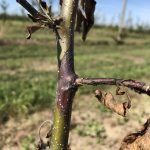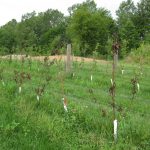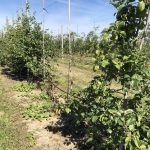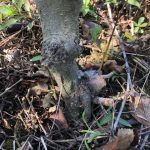Modern clonal rootstocks are the foundation-and literal roots– to modern apple growing. These rootstocks ensure growers have orchards of relatively small trees that can be densely planted and result in earlier and greater bearing than what was historically possible. This is an obvious improvement over waiting multiple decades for an orchard to become profitable. However, to become profitable, the tree needs to reach maturity and continue to yield—early maturity and early death precludes long-term sustainability. Many growers have replaced the standby rootstocks of Bud 9, M.9 clones, M.26, and Mark rootstock varieties in favor of the newer ‘replant tolerant’ Geneva rootstocks (G.11, G.41, G.935, G.210, G.969, G.890), B.10, B118, or the Vineland series.
Unfortunately, growers need to know not just what a rootstock is capable of, but what its limitations are, as well. There are no silver bullets (and besides, they are only good for werewolves, and don’t work on zombies, ghouls, vampires, etc.). University trials are limited in scope, replication, and in choice of scion. An unfortunate consequence of this is that are knowledge is limited, and there are always those situations where some scions do not perform well with certain rootstocks (I’m looking at you Honeycrisp on B9, or Rosalee on G41). On the plus side, most of the scions on most of the newer clonal stocks are smaller and begin bearing at an earlier age. This improves the bottom line by decreasing the time to produce marketable fruit and reducing the amount of pesticide required to do so, assuming the tree lives for at least 11 years, if not longer. That is a big assumption, and requires the recognition that with this smaller sized tree comes greater risk: A single canker can girdle a tree at the scion or rootstock, killing it (Fig. 1). There are several diseases that can cause this, including fire blight, Phytophthora collar rot, and bot canker.
Fire blight
Perhaps the best known canker pathogen is Erwinia amylovora, the fire blight bacterium. Historically, growers were aware of the risks posed by fire blight in orchards with large trees and blocks of susceptible varieties like Ida Red, Jonathan, or Gala, but fire blight is even more deadly to the highly susceptible Jonagold, Fuji, Gala, Ginger Gold and Pink Lady (Fig. 2; see Disease Susceptibility of Common Apple Cultivars ). Worse still, smaller trees of these new varieties can be easily girdled and the disease spread to susceptible rootstocks like M.9 and M26 (Table 1). The Geneva rootstocks are reported to have good fire blight resistance, and B.9 has always been considered tolerant. Unfortunately, M.9 and M.26 are both highly susceptible, and any infections on the sucker of a rootstock could result in a girdling lesion or systemic infection by fire blight.
Phytophthora
Succulent young suckers aren’t only an infection court for fire blight, but for Phytophthora spp., as well. Excess fertilizer results in succulent growth that cannot resist Phytophthora from infecting the root and crown of the tree. When coupled with wet conditions and pooling water (remember the flooding of 2019?), Phytophthora can become a problem (Fig. 3). Collar rot, as evaluated in trials at Geneva and other sites, refers to Phytophthora cactorum primarily, along with P. cambivora and P. cryptogea. In Indiana, Phytophthora citricola/plurivora has been a more significant problem of new plantings as well as older orchards, and there is no data regarding the resistance of Geneva rootstocks to this species. There are many Phytophthora species capable of infecting apples, and resistance to one species, like P. cactorum, doesn’t guarantee resistance to the many other species found throughout the United States.
Cutting suckers or removing them chemically provides entry courts to the Phytophthora pathogen, and could even predispose a tolerant or resistant rootstock to infection, and may explain particularly severe ‘outbreaks’ of blocks or rows of Phytophthora infection (Fig. 3). Suckers need to be removed; This is best done in warmer, drier weather that is not conducive to Phytophthora infection. Contact herbicides like glufosinate, carfentrazone or paraquat are recommended for this purpose; applications of herbicides should also occur during warmer dry weather to minimize the risk of Phytophthora infection. Unfortunately, a lot of sucker management occurs in the early spring, when trees are more likely to continue suckering, and get infected by Phytophthora.
Cankers
In orchards of smaller trees with tighter spacing, reduced airflow and thin-barked scions, some newer problems have emerged, with increases in ‘opportunistic’ canker pathogens like Phoma spp., bitter rot (Glomerella spp.), white rot and black rot (Botryosphaeria dothidea and B. obtusa, repectively). These infections may be due to poor grafting between the scion and rootstock, herbicide drift creating an injury, other predisposing conditions (poor site, deep planting, poor quality nursery stock, etc.), but we’ve received multiple reports from all over the state all exhibiting cankers. Many of these cankers are understandably misdiagnosed as fire blight (Fig. 1). Unlike fire blight, these fungal diseases cannot be managed with streptomycin, and fungicides will only protect new growth. In examining these problems, excavation of the roots usually show a failure of new growth and establishment as the main problem. In other instances, herbicide drift created an injury that the canker fungi colonized (Fig. 4).
Management
How do we prevent these problems from happening? Like anything, our choices have so much to do with the problems we encounter in the orchard (or in life). Choosing fire blight resistant scions and rootstocks need to mentioned first. This is probably the best approach for new or backyard growers to start, and then expand into more challenging varieties. The Disease susceptibility of Common Apple Cultivars provides a list of fire blight resistant varieties. Within the table, highlighted in green are the PRI varieties (Purdue, Rutgers, University of Illinois) that were bred for apple scab and other disease resistances. Paired with B.9 provides a semi-dwarf tree with good anchorage AND resistance to fire blight and some crown rots, and a greater likelihood for success. For disease resistance of root stocks, see Table 1.
The next issue is fertilizer. In the push for fast growth and reaching that top trellis wires, growers are actually producing trees with softer, more disease susceptible tissue. This results in trees that grow quickly, but not strong. The Ontario Ministry of Agriculture, Food and Rural Affairs has a great publication on Fertilizing the New Apple Orchard.
Sucker management is an interesting problem. Like so many, it is one of our own choosing, by rootstock choice and management. Cutting suckers down to ground level (or deeper) results in a fresh crop of succulent suckers—and injuries that are still susceptible to pathogens and may even promote insect pest activity (Fig.4). Lightly trimmed suckers produce more weak shoots that are just as susceptible to virulent and opportunistic pathogens, be it fire blight, Phytophthora, or bot canker. So what is a grower to do?
Tre-Hold Sprout Inhibitor A112 (15% ai), can be applied during the dormant season (for dilution in water or mixed with latex paint) or 4 weeks after petal fall when regrowth is 6–12 inches tall. Do not apply to very young or stressed trees as injury, failure to establish and stand loss may result. In young trees, suckering is often a symptom of a bigger problem.
Going forward, many of the growers I’ve worked with have been relying on Rely 280 (glufosinate) or Gramoxone (paraquat) for sucker control. For both, do not allow spray to contact green tissue (except suckers!). I cannot emphasize this enough! For glufosinate, be sure to follow the split application as per the label. Treated suckers should not exceed 12 inches in length, to minimize the risk of injury to the tree. Another option is Aim/Shark (carfentrazone-ethyl) an HRAC Group 14 Herbicide that is labeled for all tree fruits to suppress root suckers. Do not allow spray to come in contact with ANY green tissue. Trees should be established in the orchard at least one year or their trunks should be protected with an impervious trunk wrap or latex paint as any of these herbicides can cause injury if they get in contact with young bark (conservatively guessing at least 5years based upon what I’ve seen this year). Allow at least 7 (or up to 14 days, depending upon label) before reapplication. Some of these herbicides are slow to burn down, and problems with excess damage may occur if the grower impatiently reapplies trying to kill suckers before the timeframe provided in the label.
Protecting the rootstock is as important as protecting the scion, if not more so! Be sure to get the rootstock that works best for your orchard, production system, disease history, and management style to put your roots and rootstocks down in a way to establish long-term success.
Table 1. Common apple rootstock and reported disease resistances (citations 1-5, personal observations, NC-140 trial).
| Apple rootstock cultivar | Fire Blight Resistance Rating | Phytophthora Resistance Rating* |
| Bud.9 | VR | R |
| Bud. 10 | R | U |
| Bud.118 | U | VR |
| EMLA 106 | S | VS |
| Geneva 11 | S | MR |
| Geneva 16 | MS | MR |
| Geneva 30 | R | R |
| Geneva 41 | R | U |
| Geneva 65 | R | R |
| Geneva 935 | R | U |
| Mark | S | R |
| MM.106 | MS | VS |
| MM.111 | R | S-MR |
| M.7 EMLA | MS | MR |
| M.26 (EMLA, NAKB) | VS | S-VS |
| M.27 | S | MR |
| M.7 | S | S |
| M.7a | S | S |
| M.9 | S | VR |
| M.9 EMLA | S | R |
| M9 NAKBT337 | VS | S |
| M9Nic29, Burg756S | S | U |
| Ottawa 3 | VS | R |
| P.2 | VS | R |
| P.22 | VS | R |
| Vineland 3 | MS | U |
| Vineland 4 | VS | U |
VR=very resistant> MR=moderately resistant> R=resistant> MS=moderately susceptible> S=susceptible > VS=very susceptible. U = unknown/no data found.
*There are many Phytophthora species capable of infecting apples, and resistance to any one species, like P. cactorum, doesn’t guarantee resistance to the many other species found throughout the United States.
- Figure 1. A single canker can kill a young tree or rootstock. This year, bot canker was mistaken for fire blight by several growers.
- Figure 2. Fire blight can kill young trees before they ever get established.
- Figure3.Phytophthora canker (confirmed). Replanting should include use of more Phytophthora resistant rootstocks and fungicides, including the active ingredients mefenoxam and phosphorous acid.
- Figure 4. Sucker removal, weed management, and burr knots have reinforced an unhealthy rootstock situation into a fatal one.
Literature Cited
- Norelli, J. et al. 2000. Fire blight of apple rootstocks. Available online at: http://nyshs.org/wp-content/uploads/2016/10/Fire-Blight-of-Apple-Rootstocks.pdf
- Russo, N. L., Robinson, T. L., Fazio, G., and Aldwinckle, H. S. 2008. Fire blight resistance of Budagovsky 9 apple rootstock. Plant Dis. 92:385-391.
- Jones, A.L. and Aldwinckle, H.S. (editors). 1990. Compendium of Apple and Pear Diseases. The American Phytopathological Society, 3340 Pilot Knob Rd., St. Paul, MN 55121.
- Russo, N. L., Robinson, T. L., Fazio, G., & Aldwinckle, H. S. 2007. Field Evaluation of 64 Apple Rootstocks for Orchard Performance and Fire Blight Resistance. HortScience 42: 1517-1525. Retrieved Aug 24, 2020, fromhttps://journals.ashs.org/hortsci/view/journals/hortsci/42/7/article-p1517.xml
- Browne, G.T. & M. Mircetich. 1993. Relative Resistance of Thirteen Apple Rootstocks to Three Species ofPhytophthora. Phytopathology 83:744-749.



